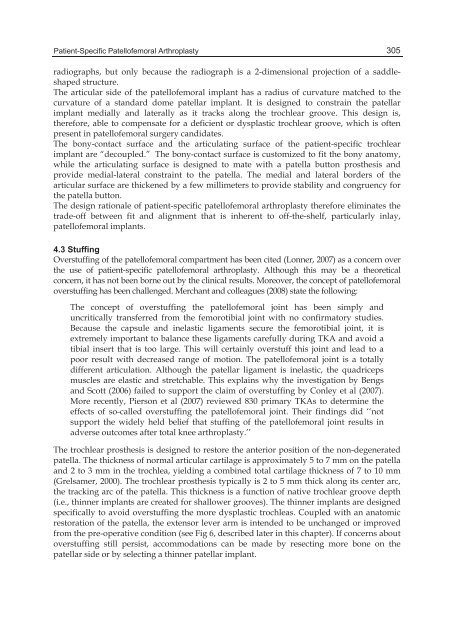RECENT ADVANCES IN HIP AND KNEE ARTHROPLASTY - Kinamed
RECENT ADVANCES IN HIP AND KNEE ARTHROPLASTY - Kinamed
RECENT ADVANCES IN HIP AND KNEE ARTHROPLASTY - Kinamed
You also want an ePaper? Increase the reach of your titles
YUMPU automatically turns print PDFs into web optimized ePapers that Google loves.
Patient-Specific Patellofemoral Arthroplasty<br />
radiographs, but only because the radiograph is a 2-dimensional projection of a saddleshaped<br />
structure.<br />
The articular side of the patellofemoral implant has a radius of curvature matched to the<br />
curvature of a standard dome patellar implant. It is designed to constrain the patellar<br />
implant medially and laterally as it tracks along the trochlear groove. This design is,<br />
therefore, able to compensate for a deficient or dysplastic trochlear groove, which is often<br />
present in patellofemoral surgery candidates.<br />
The bony-contact surface and the articulating surface of the patient-specific trochlear<br />
implant are “decoupled.” The bony-contact surface is customized to fit the bony anatomy,<br />
while the articulating surface is designed to mate with a patella button prosthesis and<br />
provide medial-lateral constraint to the patella. The medial and lateral borders of the<br />
articular surface are thickened by a few millimeters to provide stability and congruency for<br />
the patella button.<br />
The design rationale of patient-specific patellofemoral arthroplasty therefore eliminates the<br />
trade-off between fit and alignment that is inherent to off-the-shelf, particularly inlay,<br />
patellofemoral implants.<br />
4.3 Stuffing<br />
Overstuffing of the patellofemoral compartment has been cited (Lonner, 2007) as a concern over<br />
the use of patient-specific patellofemoral arthroplasty. Although this may be a theoretical<br />
concern, it has not been borne out by the clinical results. Moreover, the concept of patellofemoral<br />
overstuffing has been challenged. Merchant and colleagues (2008) state the following:<br />
The concept of overstuffing the patellofemoral joint has been simply and<br />
uncritically transferred from the femorotibial joint with no confirmatory studies.<br />
Because the capsule and inelastic ligaments secure the femorotibial joint, it is<br />
extremely important to balance these ligaments carefully during TKA and avoid a<br />
tibial insert that is too large. This will certainly overstuff this joint and lead to a<br />
poor result with decreased range of motion. The patellofemoral joint is a totally<br />
different articulation. Although the patellar ligament is inelastic, the quadriceps<br />
muscles are elastic and stretchable. This explains why the investigation by Bengs<br />
and Scott (2006) failed to support the claim of overstuffing by Conley et al (2007).<br />
More recently, Pierson et al (2007) reviewed 830 primary TKAs to determine the<br />
effects of so-called overstuffing the patellofemoral joint. Their findings did ‘‘not<br />
support the widely held belief that stuffing of the patellofemoral joint results in<br />
adverse outcomes after total knee arthroplasty.’’<br />
The trochlear prosthesis is designed to restore the anterior position of the non-degenerated<br />
patella. The thickness of normal articular cartilage is approximately 5 to 7 mm on the patella<br />
and 2 to 3 mm in the trochlea, yielding a combined total cartilage thickness of 7 to 10 mm<br />
(Grelsamer, 2000). The trochlear prosthesis typically is 2 to 5 mm thick along its center arc,<br />
the tracking arc of the patella. This thickness is a function of native trochlear groove depth<br />
(i.e., thinner implants are created for shallower grooves). The thinner implants are designed<br />
specifically to avoid overstuffing the more dysplastic trochleas. Coupled with an anatomic<br />
restoration of the patella, the extensor lever arm is intended to be unchanged or improved<br />
from the pre-operative condition (see Fig 6, described later in this chapter). If concerns about<br />
overstuffing still persist, accommodations can be made by resecting more bone on the<br />
patellar side or by selecting a thinner patellar implant.<br />
305


